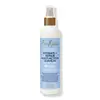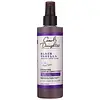What's inside
What's inside
 Key Ingredients
Key Ingredients

 Benefits
Benefits

 Concerns
Concerns

 Ingredients Side-by-side
Ingredients Side-by-side

Water
Skin ConditioningCetrimonium Chloride
AntimicrobialCaprylic/Capric Triglyceride
MaskingGlycerin
HumectantButyrospermum Parkii Butter
Skin ConditioningHoney
HumectantYogurt Powder
Yogurt Extract
Skin ConditioningInulin
Skin ConditioningAdansonia Digitata Seed Oil
EmollientTrichilia Emetica Seed Oil PEG-8 Esters
EmollientHydrolyzed Wheat Protein Pg-Propyl Silanetriol
Skin ConditioningBisabolol
MaskingTocopherol
AntioxidantStearyl Alcohol
EmollientCetyl Alcohol
EmollientTriethyl Citrate
MaskingCaprylyl Glycol
EmollientBenzoic Acid
MaskingParfum
MaskingWater, Cetrimonium Chloride, Caprylic/Capric Triglyceride, Glycerin, Butyrospermum Parkii Butter, Honey, Yogurt Powder, Yogurt Extract, Inulin, Adansonia Digitata Seed Oil, Trichilia Emetica Seed Oil PEG-8 Esters, Hydrolyzed Wheat Protein Pg-Propyl Silanetriol, Bisabolol, Tocopherol, Stearyl Alcohol, Cetyl Alcohol, Triethyl Citrate, Caprylyl Glycol, Benzoic Acid, Parfum
Water
Skin ConditioningPEG-40 Hydrogenated Castor Oil
EmulsifyingPolysorbate 20
EmulsifyingGlycerin
HumectantParfum
MaskingCitric Acid
BufferingSodium PCA
HumectantAminomethyl Propanol
BufferingPanthenol
Skin ConditioningPhenoxyethanol
PreservativeCaprylyl Glycol
EmollientBenzyl Salicylate
PerfumingCoumarin
PerfumingPotassium Sorbate
PreservativeHydrolyzed Soy Protein
HumectantAloe Barbadensis Leaf Juice
Skin ConditioningCaramel
Cosmetic ColorantHexylene Glycol
EmulsifyingBenzyl Alcohol
PerfumingLimonene
PerfumingBenzyl Benzoate
AntimicrobialLavandula Angustifolia Oil
MaskingRosmarinus Officinalis Leaf Oil
MaskingSalvia Sclarea Oil
MaskingHelianthus Annuus Seed Oil
EmollientLinalool
PerfumingPropylene Glycol
HumectantVanilla Planifolia Fruit Extract
Skin ConditioningSodium Hyaluronate
HumectantAlcohol
AntimicrobialSodium Benzoate
MaskingLamium Album Flower/Leaf/Stem Extract
Skin ConditioningRosa Centifolia Extract
Skin ConditioningCalendula Officinalis Flower Extract
MaskingWater, PEG-40 Hydrogenated Castor Oil, Polysorbate 20, Glycerin, Parfum, Citric Acid, Sodium PCA, Aminomethyl Propanol, Panthenol, Phenoxyethanol, Caprylyl Glycol, Benzyl Salicylate, Coumarin, Potassium Sorbate, Hydrolyzed Soy Protein, Aloe Barbadensis Leaf Juice, Caramel, Hexylene Glycol, Benzyl Alcohol, Limonene, Benzyl Benzoate, Lavandula Angustifolia Oil, Rosmarinus Officinalis Leaf Oil, Salvia Sclarea Oil, Helianthus Annuus Seed Oil, Linalool, Propylene Glycol, Vanilla Planifolia Fruit Extract, Sodium Hyaluronate, Alcohol, Sodium Benzoate, Lamium Album Flower/Leaf/Stem Extract, Rosa Centifolia Extract, Calendula Officinalis Flower Extract
 Reviews
Reviews

Ingredients Explained
These ingredients are found in both products.
Ingredients higher up in an ingredient list are typically present in a larger amount.
Caprylyl Glycol is a humectant and emollient, meaning it attracts and preserves moisture.
It is a common ingredient in many products, especially those designed to hydrate skin. The primary benefits are retaining moisture, skin softening, and promoting a healthy skin barrier.
Though Caprylyl Glycol is an alcohol derived from fatty acids, it is not the kind that can dry out skin.
This ingredient is also used as a preservative to extend the life of products. It has slight antimicrobial properties.
Learn more about Caprylyl GlycolGlycerin is already naturally found in your skin. It helps moisturize and protect your skin.
A study from 2016 found glycerin to be more effective as a humectant than AHAs and hyaluronic acid.
As a humectant, it helps the skin stay hydrated by pulling moisture to your skin. The low molecular weight of glycerin allows it to pull moisture into the deeper layers of your skin.
Hydrated skin improves your skin barrier; Your skin barrier helps protect against irritants and bacteria.
Glycerin has also been found to have antimicrobial and antiviral properties. Due to these properties, glycerin is often used in wound and burn treatments.
In cosmetics, glycerin is usually derived from plants such as soybean or palm. However, it can also be sourced from animals, such as tallow or animal fat.
This ingredient is organic, colorless, odorless, and non-toxic.
Glycerin is the name for this ingredient in American English. British English uses Glycerol/Glycerine.
Learn more about GlycerinParfum is a catch-all term for an ingredient or more that is used to give a scent to products.
Also called "fragrance", this ingredient can be a blend of hundreds of chemicals or plant oils. This means every product with "fragrance" or "parfum" in the ingredients list is a different mixture.
For instance, Habanolide is a proprietary trade name for a specific aroma chemical. When used as a fragrance ingredient in cosmetics, most aroma chemicals fall under the broad labeling category of “FRAGRANCE” or “PARFUM” according to EU and US regulations.
The term 'parfum' or 'fragrance' is not regulated in many countries. In many cases, it is up to the brand to define this term.
For instance, many brands choose to label themselves as "fragrance-free" because they are not using synthetic fragrances. However, their products may still contain ingredients such as essential oils that are considered a fragrance by INCI standards.
One example is Calendula flower extract. Calendula is an essential oil that still imparts a scent or 'fragrance'.
Depending on the blend, the ingredients in the mixture can cause allergies and sensitivities on the skin. Some ingredients that are known EU allergens include linalool and citronellol.
Parfum can also be used to mask or cover an unpleasant scent.
The bottom line is: not all fragrances/parfum/ingredients are created equally. If you are worried about fragrances, we recommend taking a closer look at an ingredient. And of course, we always recommend speaking with a professional.
Learn more about ParfumWater. It's the most common cosmetic ingredient of all. You'll usually see it at the top of ingredient lists, meaning that it makes up the largest part of the product.
So why is it so popular? Water most often acts as a solvent - this means that it helps dissolve other ingredients into the formulation.
You'll also recognize water as that liquid we all need to stay alive. If you see this, drink a glass of water. Stay hydrated!
Learn more about Water